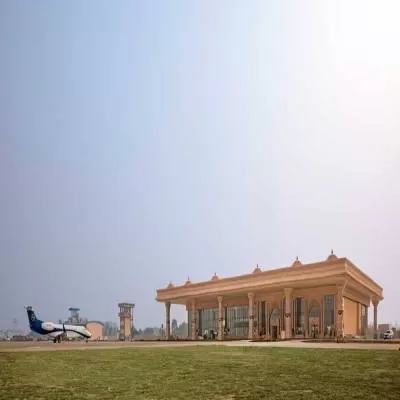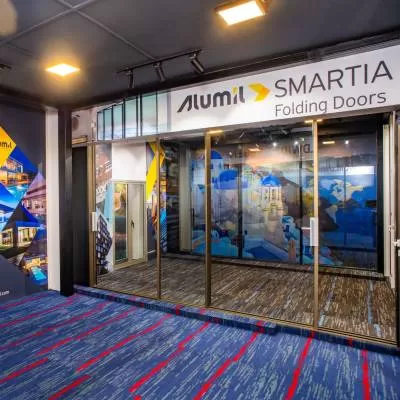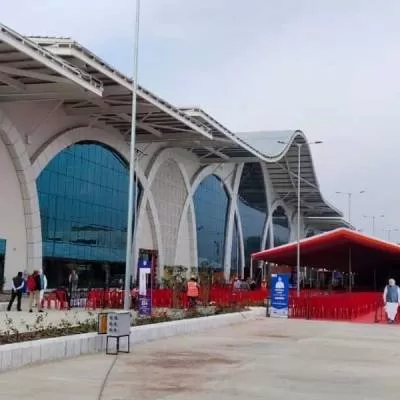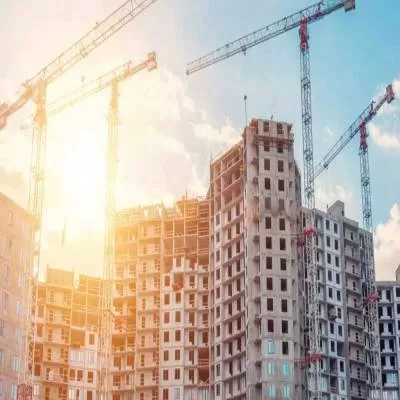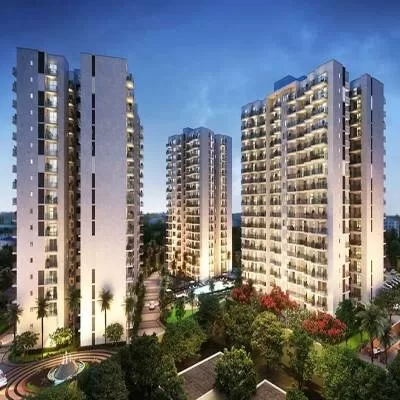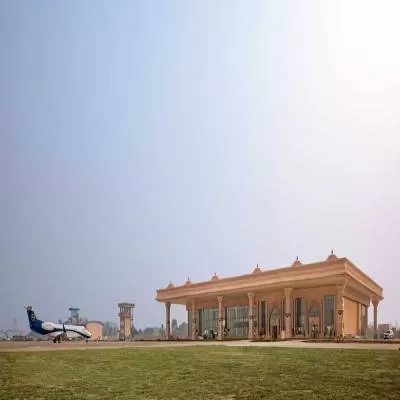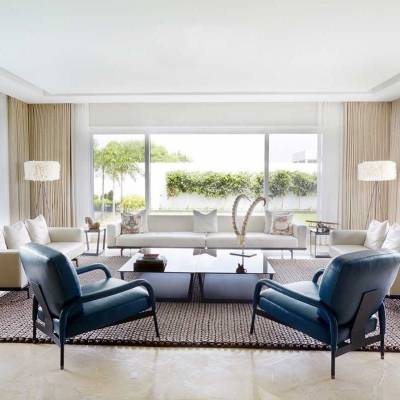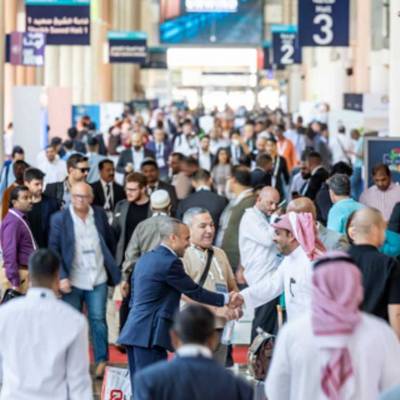- Home
- Real Estate
- An expanding material palette for façades promises to revolutionise the visual and comfort quotient of buildings in India. Here's more!

An expanding material palette for façades promises to revolutionise the visual and comfort quotient of buildings in India. Here's more!
The Indian façade industry is a happening sector, 'developing rapidly with the increasing emphasis on delivering world-class architecture,' says<span style="font-weight: bold;"> Piyush Srivastava, National Façade Manager, Schueco India.</span> <p></p> <p>While the range of materials on offer has expanded considerably, the success of the façade depends on correct installation. So, the best way forward is to use materials that are so well engineered that the scope of being incorrectly installed is eliminated, advises<span style="font-weight: bold;"> Rohit Sharma, Director, Projects, Innovators Façade Systems.</span> </p> <p>'Our focus is to engineer and manufacture systems that are foolproof, which can't be installed in any way but correctly.'</p> <p> <span style="font-weight: bold;">Preferred façades</span><br /> Aluminium and glass façades are favoured for being environment-friendly and achieving performance requirements, according to<span style="font-weight: bold;"> Rajeev Jain, Director, Windorz India.</span></p> <p>'Architects at Sobha prefer glass façades for adding beauty to the building as well as providing ample light and a sense of space,' says <span style="font-weight: bold;">Varghese PV, CEO, Glazing and Metal Works Division, Sobha.</span> 'When glass is combined with solid aluminium or composite panels such as aluminium composite panels (ACPs) and high-pressure laminates, the façade become energy-efficient as well. A glass façade costs 20-30 per cent more than the aluminium façade.' Sobha has incorporated these elements to enhance performance and aesthetics in its Infosys software development blocks projects in Hyderabad, Thiruvananthapuram and Mysuru, and at the Lulu Cyber Tower-2 in Info Park, Kochi.</p> <p> <span style="font-weight: bold;">Ubiquitous glass </span><br /> Glass has developed from clear to float, tinted and reflective to fulfil the need of the built environment, observes <span style="font-weight: bold;">GK Venkatesh, Director, Nemcon Façade</span>. 'Glass production started as clear sheet glass and progressed to clear float glass, then thermal performance through glass necessitated tinted glass commencing with bronze and diversifying to grey to green to blue. Demand for better thermal performance resulted in reflective coated glass in the same four colours. Performance through glass also progressively moved to achieve thermal insulation, acoustics and arrest of ultraviolet rays.' </p> <p>Ideally, laminated glass in a blue tint offers the best performance as well as aesthetics, as per Venkatesh. 'Blue has remained the ultimate (tint) for developments giving best colour rendition through glass.'</p> <p>A new product from Glass Future, Saint-Gobain, promises to transform the way architects and designers look at glass façades. SageGlass is a dynamically tinting product; essentially, the glass tints to any one of four levels on demand, and can be controlled by basic switches, a sophisticated building management system (BMS) or even a mobile app. 'With SageGlass, unsightly blinds that are supposed to cut off glare but which actually disconnect the occupant from the exterior world can become a thing of the past,' notes <span style="font-weight: bold;">Manish Sisodia, National Head, Glass Future, Saint-Gobain Glass India.</span></p> <p>Another Saint-Gobain product, SGG-PrivaLite is laminated glass containing a liquid crystal film between two plastic inter-layers. When the power is switched off, the glass has a naturally opaque appearance. When an electrical current is switched on, the liquid crystals align, causing the glass to turn transparent. 'By shifting from clear to opaque at the click of a button, SGG-PrivaLite allows façades to offer privacy as well as a clear view,' says Sisodia.</p> <p> <span style="font-weight: bold;">Project-specific application</span><br /> The choice of glass is highly project-specific. For instance, a commercial property located near a road junction might prioritise acoustic control and, therefore, prefer to use double-glazed laminated units.</p> <p>If better acoustical properties are essential, laminated glass is the solution, says<span style="font-weight: bold;"> Kapil Chikodi, Head, Business Development, Glass Wall Systems.</span></p> <p>Where thermal insulation is the priority, low-emissivity glass and insulated units are preferred. 'Double glazing with double low-emissivity glass and triple low-emissivity glass is being used more widely, with growing awareness that these systems control the conduction of heat,' says Varghese. 'Additionally, we are seeing the effective use of shading elements to reduce heat transfer by radiation.'</p> <p>'Insulated glass units offer good thermal insulation performance; in particular, double-glazing units with argon gas infill adds to better performance for hot climatic conditions,' says Chikodi.</p> <p>While the market for these various kinds of glass comprises both Indian companies and multinational brands, 'high-performance glass from companies like Saint Gobain, Asahi and Guardian are being preferred, especially for high-end residential project performance,' notes Chikodi.</p> <p> <span style="font-weight: bold;">Aluminium structures</span><br /> Among modern materials, aluminium is the most preferred material for façade designs, followed by stone or ACP cladding, says Srivastava.</p> <p>India has a well-developed market for aluminium systems from domestic and multinational players. 'Greater awareness of quality standards and certifications and proactive marketing are driving the adoption of globally certified façade systems from brands such as Reynaers, Technal and Schueco, albeit very gradually,' observes Jain. In general, aluminium façade structures have progressed from being structures that held glass internally to being barely visible ones, where the glass is held in place with structural sealants, notes Venkatesh.</p> <p>Schueco has introduced the FWS 60 CV, a concealed vent aluminium façade featuring a face-width of just 60 mm, which makes it impossible to distinguish open and fixed fields from the outside while from the inside, the only indications of an opening unit are a flat slim-line shadow gap and the presence of the window handle. Srivastava explains that this solution is achieved by merging the vent with the load-bearing structure, a design that maximises the transmission of light through the façade. To ensure complete safety in use, an almost invisible all-glass Juliet balcony can be integrated into the façade in front of each opening vent.</p> <p>Among the innovative advantages of modern façade systems like Schueco is their ability to maintain good air quality inside the building by integrating ventilation systems, says Srivastava. A new system from Schueco, the VentoLife, goes a step further. </p> <p>'The VentoLife is a window-integrated, automatic air purification and oxygen supply system; it allows oxygen to pass through freely, while efficiently ridding the air of small particulate matter that is harmful to health. In re-circulating air mode, the air in the room is cleaned so effectively that no further air purification devices are necessary. Outside air is added as required by means of a sensor-controlled flap to achieve optimum air quality in the building at all times.'</p> <p>Despite the benefits, Jain notes that the Indian market still remains largely price-sensitive and the absence of bye-laws for façades means many buyers tend to invest in the least expensive options, being led by appearance rather than the substance of the façade. This can have dangerous consequences. Fires in buildings can spread through façades, leading Jain to say: 'We need much more awareness of various fire-graded materials and the advantages of using high-end fire-rated sheets, even if these cost up to two-and-a-half times ordinary sheets. </p> <p>As façade contractors who are given the specifications of products to buy, we find we can hardly make a difference.' Still, 'to offer customers the best of both Indian and overseas systems, in recent years, we have used our own company sections as well as Schueco solutions fairly extensively.' </p> <p> <span style="font-weight: bold;">Design innovations</span><br /> So far, the Indian façade market has mainly focussed on façades that maximise glass areas. In this, the development of ultra-large glass panels has made it possible to design façades that offer the best views. 'Jumbo high-performance glass manufactured by Saint-Gobain under its Infinity range allows designers to re-imagine the grids, and introduce larger panels for improved views of the outside world,' explains Sisodia.</p> <p>Other innovative façade designs gaining ground in India are minimalist façades, parametric designs and interactive façades, notes Srivastava. Schueco has launched the FWS 35 PD Panorama Design façade, an ultra-slim façade system for all-glass corners and optimised views, something Srivastava explains is usually challenging to achieve because vertical mullion profiles are not used in corner areas. Its accessories include discreet connection components for sun-shading systems, of interest to any architect designing sustainable solutions, as well as burglar-resistance solutions. Then, a greater number of high-rise residential projects are embedding the balcony into the floor space and using openables like parallel openings, sliding windows, etc, which are integrated in the curtain-walling system as part of the façade, says Chikodi. A few buildings featuring this innovation are IndiaBulls Sky, IndiaBulls Blu and Prestige Kingfisher Tower in Bengaluru.</p> <p>Double-skin façades are another innovation, an interesting way to break the monotony of a glass façade while achieving significant energy savings and allowing utilisation of natural light into interiors by using various design options, says Sharma. 'A double-skin façade involves using glass as the primary façade material while creating a lightweight structure to hold another material externally, at an angle, essentially, to change the external appearance of the structure. For the Reliance TC 22 Jio building, Innovators Façade Systems combined semi-unitised glazing and a projection of unitised glazing over mild steel structures and aluminium catwalks. However, the external material could be aluminium sheet, ACPs, Canadian red cedar or even a creeper (plant) for a green façade or photovoltaic cells for an energy self-efficient building,' explains Sharma.<br /> In a nutshell, the possibilities are endless.</p> <p> <span style="font-weight: bold;">Textile Elevations</span><br /> An innovative façade material on offer from Serge Ferrari is a range of composite mesh fabrics that limit the glare effects associated with glass while offering significant thermal comfort and efficiency, explains <span style="font-weight: bold;">Arun Madappallath, Country Manager, South Asia, Serge Ferrari India.</span> </p> <p>Textile façades are obviously lighter than glass and easy to install and durable with resistance to all kinds of climates. They can be customised with 3D designs and graphic printing on fabric. </p> <p>The key challenge in their wider usage is getting acceptance for flexible façades, says Madappallath. Offices, shopping centres, health and education buildings and car parks are some potential uses. Mysuru's Y boutique hotel and Vadodara's Eva Mall feature mesh façades.</p> <p> <span style="font-weight: bold;">- Charu Bahri</span></p>


